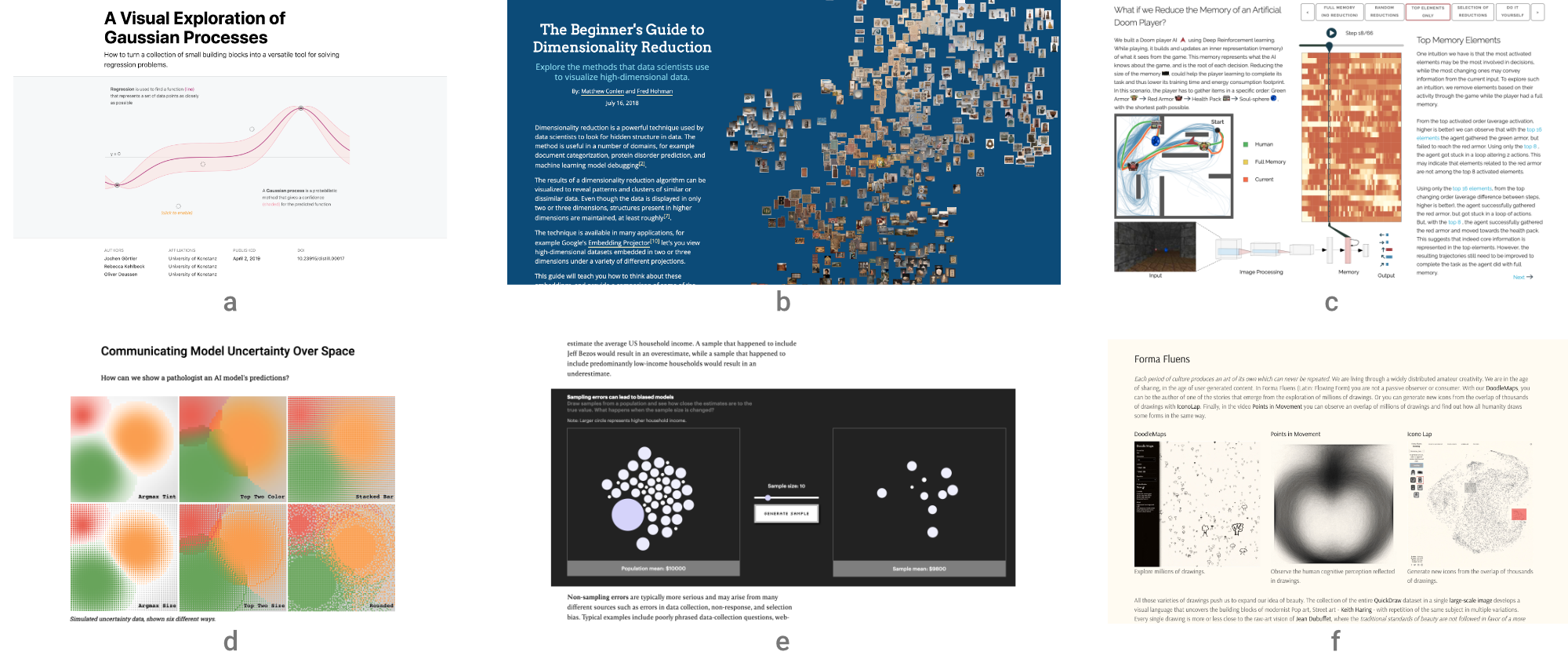
3rd Workshop on
Visualization for AI Explainability
October 26, 2020 at IEEE VIS in Salt Lake City, Utah Online
The role of visualization in artificial intelligence (AI) gained significant attention in recent years. With the growing complexity of AI models, the critical need for understanding their inner-workings has increased. Visualization is potentially a powerful technique to fill such a critical need.
The goal of this workshop is to initiate a call for "explainables" / "explorables" that explain how AI techniques work using visualization. We believe the VIS community can leverage their expertise in creating visual narratives to bring new insight into the often obfuscated complexity of AI systems.

Important Dates
Note: Dates have been revised due to the COVID-19 outbreak.
July 24, 2020August 24, 2020, anywhere: Explainables SubmissionAugust 9, 2020Sepember 24, 2020: Author NotificationSeptember 6, 2020October 13, 2020: Camera-ready Copy for Accepted SubmissionsSeptember 20, 2020VIS Registration is Free for 2020 October 26 -- Workshopin Salt Lake Cityonline at IEEE VIS 2020
Program Overview
All times in MDT (UTC -6) on October 26, 2020.
→ To attend, register for free at IEEE VIS.
→ Add to your calendar.
→ Join the virtual even here!
| 12:00 -- 12:05 | Welcome from the Organizers |
| 12:05 -- 1:00 | Keynote: Thomas Wolf (Huggingface Inc.)
Facilitating Interactive Explanations with Open-source Libraries: An Introduction to Transfer Learning in NLP and HuggingFace |
| 1:00 -- 1:30 | Session I
Comparing DNNs with UMAP Tour -- Mingwei Li and Carlos Scheidegger How Does a Computer "See" Gender? -- Stefan Wojcik, Emma Remy, and Chris Baronavski |
| 1:30 -- 2:00 | Break |
| 2:00 -- 2:30 | Session II
Théo Guesser -- Théo Jaunet, Romain Vuillemot, and Christian Wolf Shared Interest: Human Annotations vs. AI Saliency -- Angie Boggust, Benjamin Hoover, Arvind Satyanarayan, and Hendrik Strobelt A Visual Exploration of Fair Evaluation for ML - Bridging the Gap Between Research and the Real World -- Anjana Arunkumar, Swaroop Mishra, and Chris Bryan |
| 2:30 -- 3:00 | Session III
Anomagram: An Interactive Visualization for Training and Evaluating Autoencoders on the task of Anomaly Detection -- Victor Dibia What Does BERT Dream Of? -- Alex Bäuerle and James Wexler Active Learning: A Visual Tour -- Zeel B Patel and Nipun Batra |
| 3:00 -- 3:05 | Closing Session |
| 3:05 -- 4:00 | VISxAI Eastcoast party: location coming soon |
Call for Participation
SUBMISSION CLOSED
Explainable submissions (e.g., interactive articles, markup, and notebooks) are the core element of the workshop, as this workshop aims to be a platform for explanatory visualizations focusing on AI techniques.
Authors have the freedom to use whatever templates and formats they like. However, the narrative has to be visual and interactive, and walk readers through a keen understanding on the ML technique or application. Authors may wish to write a Distill-style blog post (format), interactive Idyll markup, or a Jupyter or Observable notebook that integrates code, text, and visualization to tell the story.
Here are a few examples of visual explanations of AI methods in these types of formats:
- [interactive article] A Visual Exploration of Gaussian Processes
- [interactive article] Why Momentum Really Works
- [interactive article] A Visual Introduction to Machine Learning
- [interactive article] Art-Inspired Data Experiments on Neural Network Model Decay
- [interactive article] Attacking Discrimination with Smarter Machine Learning
- [markup] The Myth of the Impartial Machine
- [markup] The Beginner's Guide to Dimensionality Reduction
- [notebook] t-SNE Explained in Plain JavaScript
- [notebook] How to build a Teachable Machine with TensorFlow.js
- [notebook] Titanic Machine Learning from Disaster
While these examples are informative and excellent, we hope the Visualization & ML community will think about ways to creatively expand on such foundational work to explain AI methods using novel interactions and visualizations often present at IEEE VIS. Please contact us, if you want to submit a original work in another format. Email: orga.visxai (at) gmail.com.
Note: We also accept more traditional papers that accompany an explainable. Be aware that we require that the explainable must stand on its own. The reviewers will evaluate the explainable (and might chose to ignore the paper).
In previous years, the best works were invited to submit their extended work to the online publishing platform distill.pub to generate a cite-able publication for authors. See https://distill.pub/2019/visual-exploration-gaussian-processes/.
Hall of Fame
Each year we award one Best Submission and two Honorable Mentions. Congrats to our winners!VISxAI 2019
- What if we Reduce the Memory of an Artificial Doom Player? -- Theo Jaunet, Romain Vuillemot, and Christian Wolf
- Statistical Distances and Their Implications to GAN Training -- Max Daniels
- Selecting the right tool for the job: a comparison of visualization algorithms -- Daniel Burkhardt, Scott Gigante, and Smita Krishnaswamy
VISxAI 2018
- A Visual Exploration of Gaussian Processes -- Jochen Görtler, Rebecca Kehlbeck and Oliver Deussen
- The Beginner's Guide to Dimensionality Reduction -- Matthew Conlen and Fred Hohman
- Roads from Above -- Greg More, Slaven Marusic and Caihao Cui
Organizers (alphabetic)
Adam Perer - Carnegie Mellon University
Duen Horng (Polo) Chau - Georgia Tech
Fernanda Viégas - Google Brain
Fred Hohman - Georgia Tech
Hendrik Strobelt - MIT-IBM Watson AI Lab
Mennatallah El-Assady - University of Konstanz
Program Committee
Marco Angelini
Jürgen Bernard
Nan Cao
Dylan Cashman
Marco Cavallo
Jaegul Choo
Tommy Dang
Angus Forbes
Sebastian Gehrmann
Fred Hohman
Iris Howley
Denis Parra
Arjun Srinivasan
Yang Wang